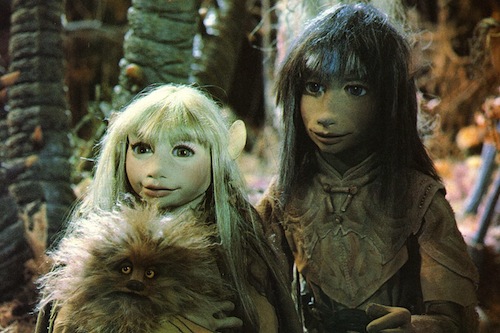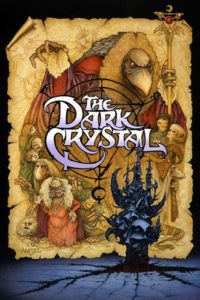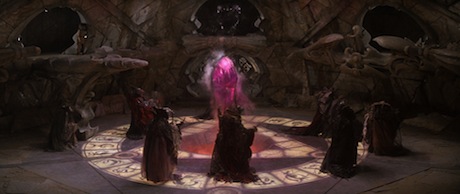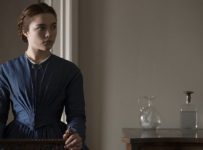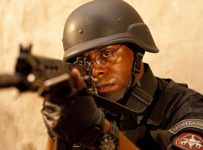Welcome back to 80s Bits, the weekly column in which we explore the best and worst of the Decade of Shame. With guest writers, hidden gems and more, it’s truly, truly, truly outrageous. We close out Muppet month with Jim Henson’s darkest creation, The Dark Crystal.
[stextbox id=”grey” caption=”The Dark Crystal (1982)” float=”true” align=”right” width=”200″]
Director: Jim Henson, Frank Oz
Writers(s): Jim Henson, Dave Odell
Runtime: 93 minutes
Starring: Stephen Garlick, Lisa Maxwell, Billie Whitelaw, Jim Henson, Frank Oz
Distributor: Universal Pictures/ITC
Country: US
Rating: Highly Recommended (?)

The work of puppeteers extraordinaire, Jim Henson and Frank Oz, The Dark Crystal (1982) is a masterpiece of advanced puppetry of its time and ambitious story-telling. Best described as a fantasy adventure film, The Dark Crystal can be overlooked as the nostalgic darker sibling of the later and lighter, family friendly Labyrinth (1986), but stands in its own right to have earned a cult status.
The Dark Crystal tells the story of the land of Thra which was divided when the Crystal of Truth shattered, becoming the ‘dark crystal’. Now two opposing races represent good and evil – the Mystics and the Skeksis. Also in this world are other beings – the cute little podlings who are sometimes captured and their essence drained to be consumed by the Skeksis as a sort of fountain of youth, various forest and swamp creatures, and the last of their race, two Gelflings – Jen and Kira. When the Skeksis sought to destroy the Gelfling race to prevent the prophesy of their demise at Gelfling hands, baby Jen was rescued and bought up by the gently lumbering mysterious Mystics, while infant Kira found her saviours in the simple, kind and fun loving Podling race.
Years later when Jen’s dying Mystic master sends him on a hero’s journey to fulfil his destiny of finding the shard that reunites the crystal, Jen ventures out and is surprised to find he is not the only Gelfling when he meets Kira, and still more surprised to find she is winged. The two experience adventure and danger at the hands of the Skeksis and their evil giant beetle-like Garthim pets, as they attempt to reunite the crystal before the Great Conjunction of Thra’s three suns.
The Dark Crystal was largely driven by Jim Henson, the same puppet master responsible for The Muppets and original Sesame Street characters, however this film is considerably darker in story line, with many scenes that would probably scare the little ones that puppets are traditionally aimed at. Jim Henson wanted to expand his successful puppet world and his own talent to deeper metaphysical explorations – good, evil, morality and mortality – and found inspiration with the The Land of Froud drawings by Brian Froud, who agreed to be the conceptual designer for The Dark Crystal.
These are no cute muppets, as Garthim attack Podlings and the vulture like Skeksis are scary even to look at in general, let alone when they are eating tiny creatures for dinner or defrocking their own kind (one of the scariest scenes I’ve witnessed by puppets).
There is some cute factor: the Gelflings are inherently cute, with their elf-like features, gentle voices and David Cassidy style 70s hair. When they haven’t been zombiefied by the Skeksis, the podlings are sweet and…well, pod like with very small round heads. Fizzgig, Kira’s spirited small fluff ball of a pet, is probably the cutest thing in the whole film and welcome light relief.
The strengths of the film are the fantasy sci-fi story line for those who are that way inclined, although it is a very simple story that has been told many times before (Lord of the Rings, anyone?). The technical skills are to be admired, with puppetry gone beyond to the realm of animatronics where mechanical, electrical ad hydraulic systems create fine movements that make you forget these creatures are not real.
The film also creates a whole visually awe-inspiring world that is reminiscent but different to earth, with elaborate and vast set designs. The music is also otherworldly, weaving a mystical pan pipe soundscape.
The characters themselves are simple stereotypes that draw you in – the gentle Gelflings, the cute Fizzgig, Aughra the eccentric horned prophetess with a Yoda talking style, and Chamberlain skekSil, the ambitious Skeksis who would be emperor only to suffer a humiliating loss, the aforementioned de-frocking and exile. With a catch phrase of a whining scheming ‘hmmmmmmm’, skekSil does inspire sympathy in his pathetic countenance post-humiliation, and tries to befriend the Gelflings, but is of dubious intention and ultimately captures Jen, although one may say this allows the prophecy to be fulfilled by putting the Gelflings right at the home of the crystal.
The moral of film is as old as time. Good versus evil is always a classic. However, another zen step is taken to show that good and evil are the same sides of one coin, the yin and the yang. The Mystics and the Skeksis were of one race until their separate entities were divided into good and evil, and may be united to become one entity again. Even divided, the Mystics and Skeksis are tied together, as when one dies or is hurt, so does one of their corresponding race.
The Dark Crystal was not a major box office success, although it was apparently big in France and Japan. The film was nominated or won several awards, including a Saturn Award for Best Fantasy Film. It is certainly not as family friendly as other Henson productions (such as Muppets Take Manhattan, The Great Muppet Caper or especially Follow that Bird) and earns a G-rating here in Australia despite some scary scenes and subject matter.
Perhaps we are underestimating the capacity for a child’s imagination to absorb stories that are challenging and mysterious. Similarly, we also need to rethink that puppetry is always a child’s game – rather it is a way to create and shape worlds and creatures, exploring human follies untethered by earthly constraints. The Dark Crystal does feel like it is the exercising of a talent that wanted to be stretched. It’s very sad that Henson died of pneumonia at the young age of 53 in 1990. Who knows what he would have gone on to inspire and create.
The Dark Crystal Trailer (1982)

